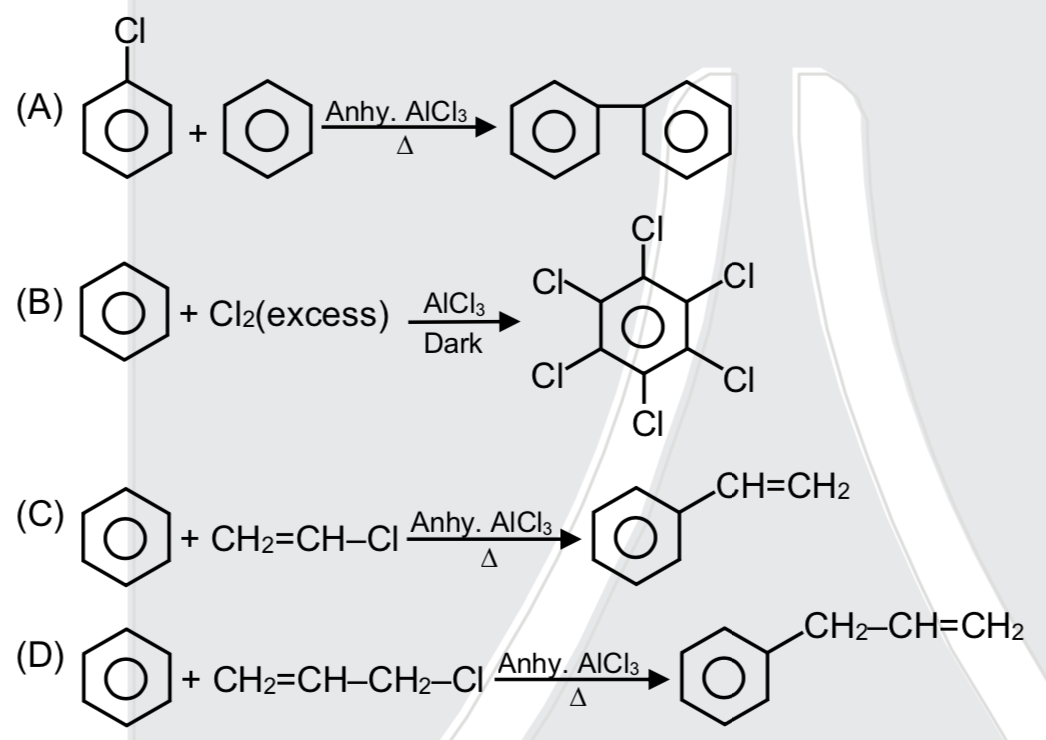Which of the following reactions are both stereospecific and regioselective ?
cis-But-2-ene +
cis-But-2-ene +
cis-But-2-ene +
trans-But-2-ene + .
The correct Answer is:A, B, C
To determine which of the given reactions are both stereospecific and regioselective, we need to understand the definitions of these terms and analyze each reaction accordingly.
1. Understanding Stereospecificity and Regioselectivity:
- Stereospecificity refers to a reaction that leads to different stereoisomeric products from different stereomeric reactants. This means that the configuration of the reactant influences the configuration of the product.
- Regioselectivity means that in a reaction, one product is formed preferentially over others. This indicates that there is a major product that is favored in the reaction.
2. Analyzing the Reactions:
- Option A:
- Reaction: cis-buto-2-ene + D2 (in presence of Pt)
- Type of addition: Syn addition
- Product: Both deuterium atoms are added on the same side, resulting in a product with a plane of symmetry (optically inactive).
- Conclusion: This reaction is both stereospecific and regioselective.
- Option B:
- Reaction: cis-but-2-ene + OsO4 + NaHSO3
- Type of addition: Syn addition
- Product: Two OH groups are added on the same side, leading to a product with a plane of symmetry (optically inactive).
- Conclusion: This reaction is also both stereospecific and regioselective.
- Option C:
- Reaction: cis-but-2-ene + Br2
- Type of addition: Anti addition
- Product: Bromine atoms are added on opposite sides, resulting in two products (mirror images).
- Conclusion: This reaction is stereospecific but not regioselective since it produces two different products.
- Option D:
- Reaction: trans-but-2-ene + PHCO3H + H2O
- Type of addition: Anti addition
- Product: The addition results in two OH groups on the same side, leading to a product with a plane of symmetry (optically inactive).
- Conclusion: This reaction is both stereospecific and regioselective.
3. Final Conclusion:
- The reactions that are both stereospecific and regioselective are:
- Option A
- Option B
- Option D
- Stereospecificity refers to a reaction that leads to different stereoisomeric products from different stereomeric reactants. This means that the configuration of the reactant influences the configuration of the product.
- Regioselectivity means that in a reaction, one product is formed preferentially over others. This indicates that there is a major product that is favored in the reaction.
- Option A:
- Reaction: cis-buto-2-ene + D2 (in presence of Pt)
- Type of addition: Syn addition
- Product: Both deuterium atoms are added on the same side, resulting in a product with a plane of symmetry (optically inactive).
- Conclusion: This reaction is both stereospecific and regioselective.
- Option B:
- Reaction: cis-but-2-ene + OsO4 + NaHSO3
- Type of addition: Syn addition
- Product: Two OH groups are added on the same side, leading to a product with a plane of symmetry (optically inactive).
- Conclusion: This reaction is also both stereospecific and regioselective.
- Option C:
- Reaction: cis-but-2-ene + Br2
- Type of addition: Anti addition
- Product: Bromine atoms are added on opposite sides, resulting in two products (mirror images).
- Conclusion: This reaction is stereospecific but not regioselective since it produces two different products.
- Option D:
- Reaction: trans-but-2-ene + PHCO3H + H2O
- Type of addition: Anti addition
- Product: The addition results in two OH groups on the same side, leading to a product with a plane of symmetry (optically inactive).
- Conclusion: This reaction is both stereospecific and regioselective.
- The reactions that are both stereospecific and regioselective are:
- Option A
- Option B
- Option D
Topper's Solved these Questions
- BOOK - CENGAGE CHEMISTRY ENGLISHCHAPTER - ORGANIC REACTION MECHANISMEXERCISE - Single correct43videos
ORGANIC REACTION MECHANISM
- BOOK - CENGAGE CHEMISTRY ENGLISHCHAPTER - ORGANIC REACTION MECHANISMEXERCISE - Assertion-Reasoning12videos
ORGANIC REACTION MECHANISM
- BOOK - CENGAGE CHEMISTRY ENGLISHCHAPTER - ORGANIC REACTION MECHANISMEXERCISE - Comprehension35videos
ORGANIC REACTION MECHANISM
- BOOK - CENGAGE CHEMISTRY ENGLISHCHAPTER - NCERT BASED EXERCISEEXERCISE - Chemical Equilibrium73videos
NCERT BASED EXERCISE
- BOOK - CENGAGE CHEMISTRY ENGLISHCHAPTER - P-BLOCK GROUP 13 - BORON FAMILYEXERCISE - Exercise Archives (Subjecive)9videos
P-BLOCK GROUP 13 - BORON FAMILY
Similar Questions
Which of the following reactions are both sterospecific and steroselective ?
View SolutionWhich of the following reaction are correct?
View SolutionWhich of the following reactions are possible ?
 View Solution
View SolutionWhich of the following reactions are possible ?
 View Solution
View SolutionWhich of the following reaction is endothermic?
View SolutionWhich of the following reactions are feasible ?
View SolutionWhich of the following reactions is correct?
View SolutionWhich of the following reactions(s) is/are both non-sterospecific but steroselective ?
View SolutionWhich of the following reaction is not feasible?
View SolutionWhich of the following is redox reaction ?
View Solution
